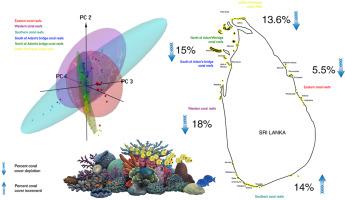Ocean & Coastal Management ( IF 4.8 ) Pub Date : 2021-05-04 , DOI: 10.1016/j.ocecoaman.2021.105667 Gajaba Ellepola , Samitha Harischandra , Kithsiri B. Ranawana

|
Spatial distribution patterns of coral reefs are maintained by a magnitude of chemical, physical and biological factors. Being a small continental island in the Indian Ocean, the extent of coral reef habitats around Sri Lanka has been limited and patchy showing unique, regional distribution patterns owing to these factors. However, the available data on these factors are sparse and outdated hindering proper management implications of these coral reefs. Here, we use remote sensing data on coral reefs in providing a framework to formulate hypotheses about the ecological processes governing these spatial and temporal patterns of coral reef distribution around the country. The results explained that the coral reef habitats around Sri Lanka are mostly shaped by the variation in nutrient levels (phosphate, nitrate and silicate), annual variance in sea surface salinity, mean current velocity and bathymetric shape. The study identified four unique coral reef areas around the island owing to variations of these factors; east coast reefs, south coast reefs, west coast reefs and north/northwestern reefs around Jaffna peninsula and Gulf of Mannar. The predicted Maximum entropy distribution models for the coral reef habitats of Sri Lanka revealed a significant amount of coral reef cover around the island (~2739 km2) which might deplete by ~4% in another 30 years due to changes in these factors. The highest amount of loss will be in the west coast (~17.76%) and least amount of loss will be in the east coast (~5.54%). The current research aids in understanding the reef ecology around Sri Lanka and provides implications for marine ecosystem management and conservation planning.
中文翻译:

地球物理和环境因素的空间分析表征了斯里兰卡周围不同的珊瑚礁栖息地。对管理的意义
珊瑚礁的空间分布格局是由一定数量的化学,物理和生物因素维持的。作为印度洋上的一个小大陆岛,由于这些因素,斯里兰卡周围的珊瑚礁栖息地范围有限,且斑驳,显示出独特的区域分布格局。但是,有关这些因素的可用数据稀疏且过时,阻碍了这些珊瑚礁的适当管理。在这里,我们使用有关珊瑚礁的遥感数据来提供一个框架,以表达关于支配全国各地珊瑚礁分布的这些时空格局的生态过程的假设。结果说明,斯里兰卡周围的珊瑚礁栖息地大多受养分水平(磷酸盐,硝酸盐和硅酸盐)变化的影响,海面盐度,平均流速和测深形状的年变化。由于这些因素的变化,该研究确定了岛上四个独特的珊瑚礁区域。贾夫纳半岛和马纳尔湾周围的东海岸礁,南海岸礁,西海岸礁和北/西北礁。斯里兰卡珊瑚礁栖息地的预测最大熵分布模型显示,该岛周围有大量珊瑚礁覆盖(约2739公里)2)由于这些因素的变化,在未来30年内可能会减少约4%。损失最高的将在西海岸(〜17.76%),而损失最小的将在东海岸(〜5.54%)。当前的研究有助于了解斯里兰卡周围的珊瑚礁生态,并为海洋生态系统管理和保护规划提供启示。











































 京公网安备 11010802027423号
京公网安备 11010802027423号